Weiping Wang
NeedleInATable: Exploring Long-Context Capability of Large Language Models towards Long-Structured Tables
Apr 09, 2025Abstract:Processing structured tabular data, particularly lengthy tables, constitutes a fundamental yet challenging task for large language models (LLMs). However, existing long-context benchmarks primarily focus on unstructured text, neglecting the challenges of long and complex structured tables. To address this gap, we introduce NeedleInATable (NIAT), a novel task that treats each table cell as a "needle" and requires the model to extract the target cell under different queries. Evaluation results of mainstream LLMs on this benchmark show they lack robust long-table comprehension, often relying on superficial correlations or shortcuts for complex table understanding tasks, revealing significant limitations in processing intricate tabular data. To this end, we propose a data synthesis method to enhance models' long-table comprehension capabilities. Experimental results show that our synthesized training data significantly enhances LLMs' performance on the NIAT task, outperforming both long-context LLMs and long-table agent methods. This work advances the evaluation of LLMs' genuine long-structured table comprehension capabilities and paves the way for progress in long-context and table understanding applications.
BeamLoRA: Beam-Constraint Low-Rank Adaptation
Feb 19, 2025Abstract:Due to the demand for efficient fine-tuning of large language models, Low-Rank Adaptation (LoRA) has been widely adopted as one of the most effective parameter-efficient fine-tuning methods. Nevertheless, while LoRA improves efficiency, there remains room for improvement in accuracy. Herein, we adopt a novel perspective to assess the characteristics of LoRA ranks. The results reveal that different ranks within the LoRA modules not only exhibit varying levels of importance but also evolve dynamically throughout the fine-tuning process, which may limit the performance of LoRA. Based on these findings, we propose BeamLoRA, which conceptualizes each LoRA module as a beam where each rank naturally corresponds to a potential sub-solution, and the fine-tuning process becomes a search for the optimal sub-solution combination. BeamLoRA dynamically eliminates underperforming sub-solutions while expanding the parameter space for promising ones, enhancing performance with a fixed rank. Extensive experiments across three base models and 12 datasets spanning math reasoning, code generation, and commonsense reasoning demonstrate that BeamLoRA consistently enhances the performance of LoRA, surpassing the other baseline methods.
AS-GCL: Asymmetric Spectral Augmentation on Graph Contrastive Learning
Feb 19, 2025Abstract:Graph Contrastive Learning (GCL) has emerged as the foremost approach for self-supervised learning on graph-structured data. GCL reduces reliance on labeled data by learning robust representations from various augmented views. However, existing GCL methods typically depend on consistent stochastic augmentations, which overlook their impact on the intrinsic structure of the spectral domain, thereby limiting the model's ability to generalize effectively. To address these limitations, we propose a novel paradigm called AS-GCL that incorporates asymmetric spectral augmentation for graph contrastive learning. A typical GCL framework consists of three key components: graph data augmentation, view encoding, and contrastive loss. Our method introduces significant enhancements to each of these components. Specifically, for data augmentation, we apply spectral-based augmentation to minimize spectral variations, strengthen structural invariance, and reduce noise. With respect to encoding, we employ parameter-sharing encoders with distinct diffusion operators to generate diverse, noise-resistant graph views. For contrastive loss, we introduce an upper-bound loss function that promotes generalization by maintaining a balanced distribution of intra- and inter-class distance. To our knowledge, we are the first to encode augmentation views of the spectral domain using asymmetric encoders. Extensive experiments on eight benchmark datasets across various node-level tasks demonstrate the advantages of the proposed method.
Communication-Efficient Personalized Federal Graph Learning via Low-Rank Decomposition
Dec 18, 2024Abstract:Federated graph learning (FGL) has gained significant attention for enabling heterogeneous clients to process their private graph data locally while interacting with a centralized server, thus maintaining privacy. However, graph data on clients are typically non-IID, posing a challenge for a single model to perform well across all clients. Another major bottleneck of FGL is the high cost of communication. To address these challenges, we propose a communication-efficient personalized federated graph learning algorithm, CEFGL. Our method decomposes the model parameters into low-rank generic and sparse private models. We employ a dual-channel encoder to learn sparse local knowledge in a personalized manner and low-rank global knowledge in a shared manner. Additionally, we perform multiple local stochastic gradient descent iterations between communication phases and integrate efficient compression techniques into the algorithm. The advantage of CEFGL lies in its ability to capture common and individual knowledge more precisely. By utilizing low-rank and sparse parameters along with compression techniques, CEFGL significantly reduces communication complexity. Extensive experiments demonstrate that our method achieves optimal classification accuracy in a variety of heterogeneous environments across sixteen datasets. Specifically, compared to the state-of-the-art method FedStar, the proposed method (with GIN as the base model) improves accuracy by 5.64\% on cross-datasets setting CHEM, reduces communication bits by a factor of 18.58, and reduces the communication time by a factor of 1.65.
Improving Mathematical Reasoning Capabilities of Small Language Models via Feedback-Driven Distillation
Nov 22, 2024Abstract:Large Language Models (LLMs) demonstrate exceptional reasoning capabilities, often achieving state-of-the-art performance in various tasks. However, their substantial computational and memory demands, due to billions of parameters, hinder deployment in resource-constrained environments. A promising solution is knowledge distillation, where LLMs transfer reasoning capabilities to Small Language Models (SLMs, $\le$ 1B parameters), enabling wider deployment on low-resource devices. Existing methods primarily focus on generating high-quality reasoning rationales for distillation datasets but often neglect the critical role of data quantity and quality. To address these challenges, we propose a Feedback-Driven Distillation (FDD) framework to enhance SLMs' mathematical reasoning capabilities. In the initialization stage, a distillation dataset is constructed by prompting LLMs to pair mathematical problems with corresponding reasoning rationales. We classify problems into easy and hard categories based on SLM performance. For easy problems, LLMs generate more complex variations, while for hard problems, new questions of similar complexity are synthesized. In addition, we propose a multi-round distillation paradigm to iteratively enrich the distillation datasets, thereby progressively improving the mathematical reasoning abilities of SLMs. Experimental results demonstrate that our method can make SLMs achieve SOTA mathematical reasoning performance.
A Multi-Task Role-Playing Agent Capable of Imitating Character Linguistic Styles
Nov 04, 2024



Abstract:The advent of large language models (LLMs) has significantly propelled the advancement of Role-Playing Agents (RPAs). However, current Role-Playing Agents predominantly focus on mimicking a character's fundamental attributes while neglecting the replication of linguistic style, and they are incapable of effectively replicating characters when performing tasks beyond multi-turn dialogues, which results in generated responses that lack authenticity. The reason current RPAs lack this capability is due to the nature of existing character datasets, which lack collections of character quotations and are limited to multi-turn dialogue tasks, constraining the RPA's performance across other task domains and failing to mimic a character's linguistic style. To address this gap, we developed a multi-task role-playing dataset named MRstyle, which encompasses a substantial number of real individuals along with their quotations and covers seven different tasks. On this basis, we develop StyleRPA, a Multi-Task Role-Playing Agent (MRPA) that significantly outperforms recent open-source LLMs and RPAs baselines on 7 tasks including Dialogue, Dictionary, Composition, Story Generation, Product Description, Music Commentary, and Open Question Answering. The code and data will be released.
RealEra: Semantic-level Concept Erasure via Neighbor-Concept Mining
Oct 11, 2024

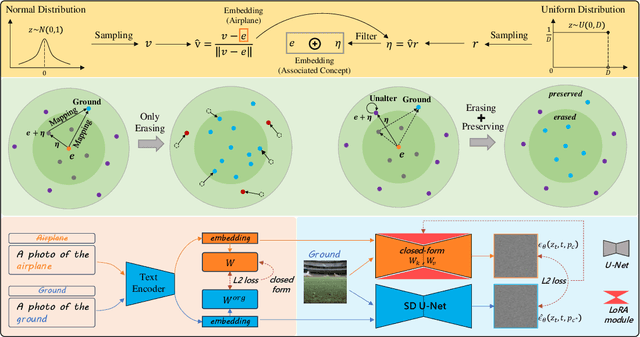
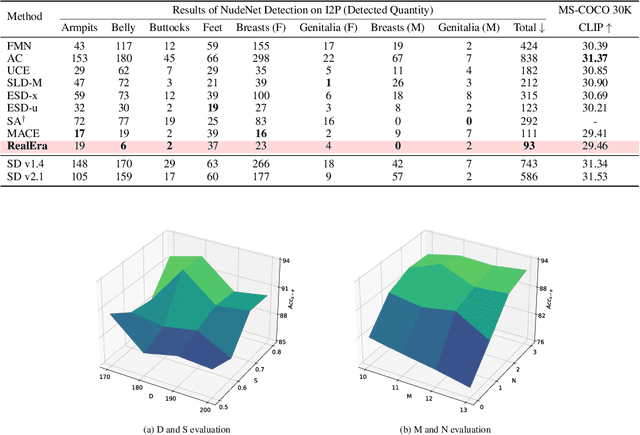
Abstract:The remarkable development of text-to-image generation models has raised notable security concerns, such as the infringement of portrait rights and the generation of inappropriate content. Concept erasure has been proposed to remove the model's knowledge about protected and inappropriate concepts. Although many methods have tried to balance the efficacy (erasing target concepts) and specificity (retaining irrelevant concepts), they can still generate abundant erasure concepts under the steering of semantically related inputs. In this work, we propose RealEra to address this "concept residue" issue. Specifically, we first introduce the mechanism of neighbor-concept mining, digging out the associated concepts by adding random perturbation into the embedding of erasure concept, thus expanding the erasing range and eliminating the generations even through associated concept inputs. Furthermore, to mitigate the negative impact on the generation of irrelevant concepts caused by the expansion of erasure scope, RealEra preserves the specificity through the beyond-concept regularization. This makes irrelevant concepts maintain their corresponding spatial position, thereby preserving their normal generation performance. We also employ the closed-form solution to optimize weights of U-Net for the cross-attention alignment, as well as the prediction noise alignment with the LoRA module. Extensive experiments on multiple benchmarks demonstrate that RealEra outperforms previous concept erasing methods in terms of superior erasing efficacy, specificity, and generality. More details are available on our project page https://realerasing.github.io/RealEra/ .
Relation Also Knows: Rethinking the Recall and Editing of Factual Associations in Auto-Regressive Transformer Language Models
Aug 27, 2024



Abstract:The storage and recall of factual associations in auto-regressive transformer language models (LMs) have drawn a great deal of attention, inspiring knowledge editing by directly modifying the located model weights. Most editing works achieve knowledge editing under the guidance of existing interpretations of knowledge recall that mainly focus on subject knowledge. However, these interpretations are seriously flawed, neglecting relation information and leading to the over-generalizing problem for editing. In this work, we discover a novel relation-focused perspective to interpret the knowledge recall of transformer LMs during inference and apply it on knowledge editing to avoid over-generalizing. Experimental results on the dataset supplemented with a new R-Specificity criterion demonstrate that our editing approach significantly alleviates over-generalizing while remaining competitive on other criteria, breaking the domination of subject-focused editing for future research.
Towards Flexible Evaluation for Generative Visual Question Answering
Aug 01, 2024



Abstract:Throughout rapid development of multimodal large language models, a crucial ingredient is a fair and accurate evaluation of their multimodal comprehension abilities. Although Visual Question Answering (VQA) could serve as a developed test field, limitations of VQA evaluation, like the inflexible pattern of Exact Match, have hindered MLLMs from demonstrating their real capability and discourage rich responses. Therefore, this paper proposes the use of semantics-based evaluators for assessing unconstrained open-ended responses on VQA datasets. As characteristics of VQA have made such evaluation significantly different than the traditional Semantic Textual Similarity (STS) task, to systematically analyze the behaviour and compare the performance of various evaluators including LLM-based ones, we proposes three key properties, i.e., Alignment, Consistency and Generalization, and a corresponding dataset Assessing VQA Evaluators (AVE) to facilitate analysis. In addition, this paper proposes a Semantically Flexible VQA Evaluator (SFVE) with meticulous design based on the unique features of VQA evaluation. Experimental results verify the feasibility of model-based VQA evaluation and effectiveness of the proposed evaluator that surpasses existing semantic evaluators by a large margin. The proposed training scheme generalizes to both the BERT-like encoders and decoder-only LLM.
Key-Point-Driven Mathematical Reasoning Distillation of Large Language Model
Jul 14, 2024
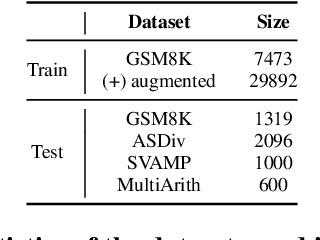
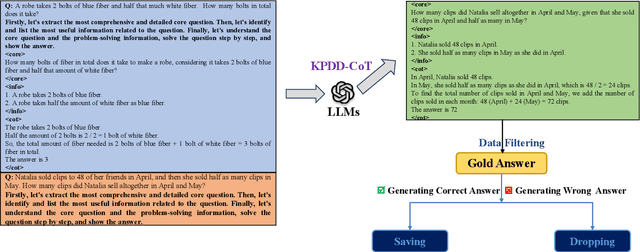
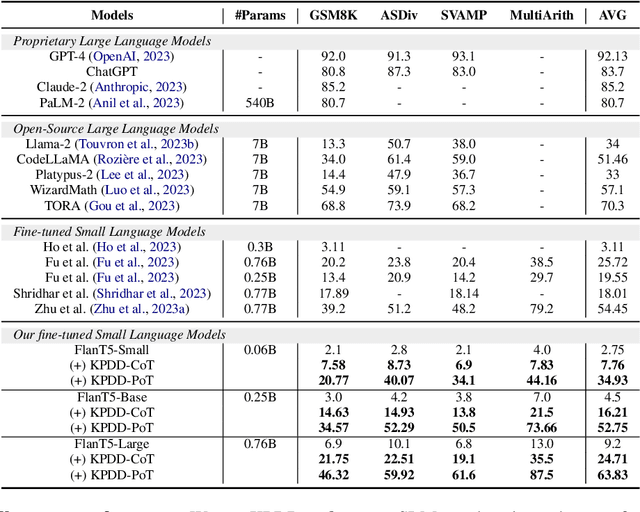
Abstract:Large Language Models (LLMs) have demonstrated exceptional proficiency in mathematical reasoning tasks due to their extensive parameter counts and training on vast datasets. Despite these capabilities, deploying LLMs is hindered by their computational demands. Distilling LLM mathematical reasoning into Smaller Language Models (SLMs) has emerged as a solution to this challenge, although these smaller models often suffer from errors in calculation and semantic understanding. Prior work has proposed Program-of-Thought Distillation (PoTD) to avoid calculation error. To further address semantic understanding errors, we propose Key-Point-Driven Mathematical Reasoning Distillation (KPDD). KPDD enhances the reasoning performance of SLMs by breaking down the problem-solving process into three stages: Core Question Extraction, Problem-Solving Information Extraction, and Step-by-Step Solution. This method is further divided into KPDD-CoT, which generates Chain-of-Thought rationales, and KPDD-PoT, which creates Program-of-Thought rationales. The experiment results show that KPDD-CoT significantly improves reasoning abilities, while KPDD-PoT achieves state-of-the-art performance in mathematical reasoning tasks. Our approach effectively mitigates misunderstanding errors, advancing the deployment of efficient and capable SLMs.
 Add to Chrome
Add to Chrome Add to Firefox
Add to Firefox Add to Edge
Add to Edge